The Endometrial Cancer Treatment Market is estimated to be valued at USD 32.0 billion in 2025 and is projected to reach USD 53.7 billion by 2035, registering a compound annual growth rate (CAGR) of 5.3% over the forecast period.
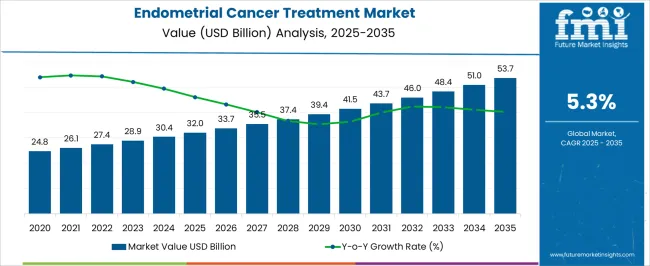
| Metric | Value |
|---|---|
| Endometrial Cancer Treatment Market Estimated Value in (2025 E) | USD 32.0 billion |
| Endometrial Cancer Treatment Market Forecast Value in (2035 F) | USD 53.7 billion |
| Forecast CAGR (2025 to 2035) | 5.3% |
The Endometrial Cancer Treatment market is witnessing steady expansion, supported by the growing prevalence of gynecological cancers and the rising awareness about early screening and diagnosis. Increasing incidence of endometrial cancer, particularly among women over the age of 50, is driving demand for effective treatment regimens. Progress in oncology research and the development of novel therapies are enhancing treatment outcomes, while supportive government programs and awareness initiatives are contributing to higher diagnosis and treatment rates.
The market is also being shaped by the rising adoption of precision medicine, where treatment approaches are tailored according to genetic and molecular profiling. Moreover, ongoing advancements in targeted drug delivery and combination therapies are providing patients with improved efficacy and reduced side effects.
As healthcare infrastructure expands in emerging economies, access to oncology care is improving, leading to wider treatment adoption With pharmaceutical companies investing in research pipelines and healthcare providers focusing on integrated cancer management, the Endometrial Cancer Treatment market is positioned for long-term growth, supported by both innovation and increasing patient needs.
The endometrial cancer treatment market is segmented by treatment type, end user, and geographic regions. By treatment type, endometrial cancer treatment market is divided into Chemotherapy, Hormonal Therapy, Radiation Therapy, and Surgery. In terms of end user, endometrial cancer treatment market is classified into Retail Pharmacy, Hospital Pharmacy, and Clinics. Regionally, the endometrial cancer treatment industry is classified into North America, Latin America, Western Europe, Eastern Europe, Balkan & Baltic Countries, Russia & Belarus, Central Asia, East Asia, South Asia & Pacific, and the Middle East & Africa.
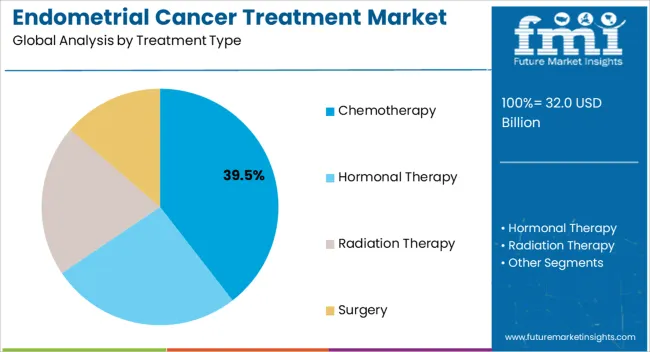
The chemotherapy segment is projected to hold 39.5% of the Endometrial Cancer Treatment market revenue share in 2025, making it the leading treatment type. This growth is being driven by the widespread use of chemotherapy as a standard treatment option for advanced or recurrent cases of endometrial cancer. Chemotherapy provides systemic control by targeting cancer cells that may have spread beyond the uterus, which makes it a critical option in combination with surgery or radiation therapy.
Ongoing innovations in drug formulations and delivery mechanisms are improving tolerability and effectiveness, while combination regimens are demonstrating enhanced survival outcomes. Patient demand for therapies with proven efficacy and physician preference for established protocols continue to strengthen the role of chemotherapy.
Despite the availability of newer targeted therapies, chemotherapy remains cost-effective and widely accessible across diverse healthcare systems The growing focus on integrating chemotherapy with precision medicine approaches and immunotherapies is expected to further enhance its clinical value, ensuring its continued prominence in treatment strategies for endometrial cancer.
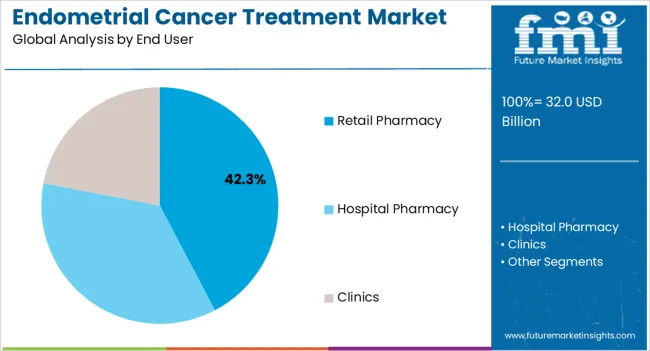
The retail pharmacy segment is anticipated to account for 42.3% of the market revenue share in 2025, positioning it as the leading end-user channel. The growth of this segment is being supported by the increasing reliance of patients on retail pharmacies for convenient access to prescribed medications and supportive therapies. Retail pharmacies play a vital role in improving treatment adherence by offering counseling services, medication reminders, and affordable drug alternatives.
Their widespread distribution networks and accessibility in both urban and rural areas make them essential in ensuring continuous availability of cancer therapies. The expansion of specialty pharmacy services within retail outlets is further enabling the distribution of oncology drugs that require specific handling and monitoring.
Moreover, partnerships between retail pharmacies and healthcare providers are enhancing patient support programs, facilitating better disease management As the number of patients receiving outpatient care grows and healthcare systems emphasize convenience and cost efficiency, the retail pharmacy segment is expected to strengthen its leadership position, driven by accessibility, affordability, and integrated service offerings.
Endometrial cancer or uterine cancer is one of the most common gynecological cancers and 2.8% of women are diagnosed with the endometrial cancer at some point in their lives. According to National Cancer Institute statistics, in 2025 endometrial cancer contributed to 1.8% of all cancers and 3.6% of all new cancer cases were diagnosed as endometrial cancer.
Early detection of endometrial cancer helps in the selection of proper treatment options. Endometrial cancers are typically diagnosed as type I and type II tumors and majority of the patients diagnosed with endometrial cancer represent early-stage cancers.
According to Yale University School of Medicine, USA, in 2025, type I tumors constitute 80% of all cases of endometrial cancers diagnosed in the USA Endometrial cancer can be treated by one or combination of chemotherapy, radiation therapy and hormone therapy.
Most of the physicians recommend combination treatments as chemotherapy alone has traditionally been deem ineffective. Adjuvant radiation therapy is preferred in patients who have diagnosed with sage I or II endometrial cancer. Radiation therapy is also recommended in patients who have undergone the surgery, in order to avoid the relapse of endometrial cancer.
Endometrial cancer is often detected in women above the age of 50 years and risk of endometrial cancer increases with the age. Also the risk of development of endometrial cancer is more in breast cancer patients who are being treated with tamoxifen or estrogen for long time.
Plenty of chemotherapeutic agents are available and are recommended in the combination for the treatment of endometrial cancer. Some of the combination therapies include carboplatin & paclitaxel, Cisplatin & doxorubicin, Carboplatin & docetaxel and others.
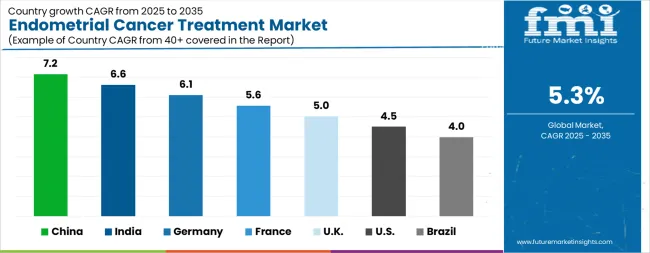
| Country | CAGR |
|---|---|
| China | 7.2% |
| India | 6.6% |
| Germany | 6.1% |
| France | 5.6% |
| UK | 5.0% |
| USA | 4.5% |
| Brazil | 4.0% |
The Endometrial Cancer Treatment Market is expected to register a CAGR of 5.3% during the forecast period, exhibiting varied country level momentum. China leads with the highest CAGR of 7.2%, followed by India at 6.6%. Developed markets such as Germany, France, and the UK continue to expand steadily, while the USA is likely to grow at consistent rates. Brazil posts the lowest CAGR at 4.0%, yet still underscores a broadly positive trajectory for the global Endometrial Cancer Treatment Market. In 2024, Germany held a dominant revenue in the Western Europe market and is expected to grow with a CAGR of 6.1%. The USA Endometrial Cancer Treatment Market is estimated to be valued at USD 11.3 billion in 2025 and is anticipated to reach a valuation of USD 17.6 billion by 2035. Sales are projected to rise at a CAGR of 4.5% over the forecast period between 2025 and 2035. While Japan and South Korea markets are estimated to be valued at USD 1.5 billion and USD 823.5 million respectively in 2025.
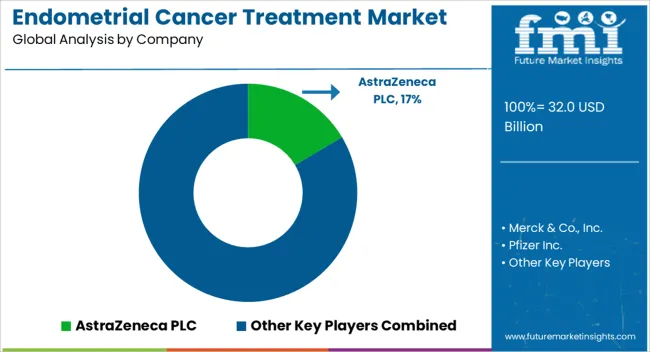
| Item | Value |
|---|---|
| Quantitative Units | USD 32.0 Billion |
| Treatment Type | Chemotherapy, Hormonal Therapy, Radiation Therapy, and Surgery |
| End User | Retail Pharmacy, Hospital Pharmacy, and Clinics |
| Regions Covered | North America, Europe, Asia-Pacific, Latin America, Middle East & Africa |
| Country Covered | United States, Canada, Germany, France, United Kingdom, China, Japan, India, Brazil, South Africa |
| Key Companies Profiled | AstraZeneca PLC, Merck & Co., Inc., Pfizer Inc., GSK plc, Novartis AG, Eisai Co., Ltd., Alpine Life Sciences Private Limited, Varian Medical Systems, Inc. (Siemens Healthineers AG), Sun Pharmaceutical Industries Limited, and Teva Pharmaceutical Industries Ltd. |
The global endometrial cancer treatment market is estimated to be valued at USD 32.0 billion in 2025.
The market size for the endometrial cancer treatment market is projected to reach USD 53.7 billion by 2035.
The endometrial cancer treatment market is expected to grow at a 5.3% CAGR between 2025 and 2035.
The key product types in endometrial cancer treatment market are chemotherapy, _carboplatin, _paclitaxel, _ixabepilone, _others, hormonal therapy, _megestrol (megace), _medroxyprogesterone (provera), _others (anastrozole, letrozole, etc.), radiation therapy, _whole pelvic external-beam radiation therapy, _vaginal brachytherapy, surgery, _hysterectomy and _bilateral salpingo-oophorectomy.
In terms of end user, retail pharmacy segment to command 42.3% share in the endometrial cancer treatment market in 2025.






Our Research Products

The "Full Research Suite" delivers actionable market intel, deep dives on markets or technologies, so clients act faster, cut risk, and unlock growth.

The Leaderboard benchmarks and ranks top vendors, classifying them as Established Leaders, Leading Challengers, or Disruptors & Challengers.

Locates where complements amplify value and substitutes erode it, forecasting net impact by horizon

We deliver granular, decision-grade intel: market sizing, 5-year forecasts, pricing, adoption, usage, revenue, and operational KPIs—plus competitor tracking, regulation, and value chains—across 60 countries broadly.

Spot the shifts before they hit your P&L. We track inflection points, adoption curves, pricing moves, and ecosystem plays to show where demand is heading, why it is changing, and what to do next across high-growth markets and disruptive tech

Real-time reads of user behavior. We track shifting priorities, perceptions of today’s and next-gen services, and provider experience, then pace how fast tech moves from trial to adoption, blending buyer, consumer, and channel inputs with social signals (#WhySwitch, #UX).

Partner with our analyst team to build a custom report designed around your business priorities. From analysing market trends to assessing competitors or crafting bespoke datasets, we tailor insights to your needs.
Supplier Intelligence
Discovery & Profiling
Capacity & Footprint
Performance & Risk
Compliance & Governance
Commercial Readiness
Who Supplies Whom
Scorecards & Shortlists
Playbooks & Docs
Category Intelligence
Definition & Scope
Demand & Use Cases
Cost Drivers
Market Structure
Supply Chain Map
Trade & Policy
Operating Norms
Deliverables
Buyer Intelligence
Account Basics
Spend & Scope
Procurement Model
Vendor Requirements
Terms & Policies
Entry Strategy
Pain Points & Triggers
Outputs
Pricing Analysis
Benchmarks
Trends
Should-Cost
Indexation
Landed Cost
Commercial Terms
Deliverables
Brand Analysis
Positioning & Value Prop
Share & Presence
Customer Evidence
Go-to-Market
Digital & Reputation
Compliance & Trust
KPIs & Gaps
Outputs
Full Research Suite comprises of:
Market outlook & trends analysis
Interviews & case studies
Strategic recommendations
Vendor profiles & capabilities analysis
5-year forecasts
8 regions and 60+ country-level data splits
Market segment data splits
12 months of continuous data updates
DELIVERED AS:
PDF EXCEL ONLINE
Blood Cancer Treatment Market Growth – Trends & Forecast 2025 to 2035
Penile Cancer Treatment Market Size and Share Forecast Outlook 2025 to 2035
Glottic Cancer Treatment Market
Cervical Cancer Treatment Market Size and Share Forecast Outlook 2025 to 2035
Testicular Cancer Treatment Market
Biliary Tract Cancers Treatment Market Analysis - Size, Share, and Forecast Outlook 2025 to 2035
Key Players & Market Share in the Biliary Tract Cancers (BTCs) Treatment Industry
Small Cell Lung Cancer (SCLC) Treatment Market Size and Share Forecast Outlook 2025 to 2035
Kinase Inhibitors For Cancer Treatment Market Size and Share Forecast Outlook 2025 to 2035
PD1 Non-Small Cell Lung Cancer Treatment Market - Growth & Outlook 2025 to 2035
Japan Biliary Tract Cancers (BTCs) Treatment Market Growth – Demand, Trends & Forecast 2025-2035
China Biliary Tract Cancers (BTCs) Treatment Market Analysis – Size, Share & Forecast 2025-2035
Germany Biliary Tract Cancers (BTCs) Treatment Market Trends – Demand, Innovations & Forecast 2025-2035
Adoptive Cell Therapy for Cancer Treatment Market
Australia Biliary Tract Cancers (BTCs) Treatment Market Insights – Size, Share & Industry Growth 2025-2035
United States Biliary Tract Cancers (BTCs) Treatment Market Analysis – Size, Share & Trends 2025-2035
Castration-Resistant Prostate Cancer (CRPC) Treatment Market Insights - Demand, Size & Industry Trends 2025 to 2035
Hormone Sensitive Advanced Prostate Cancer Treatment Market Size and Share Forecast Outlook 2025 to 2035
Cancer Registry Software Market Size and Share Forecast Outlook 2025 to 2035
Cancer Biological Therapy Market Size and Share Forecast Outlook 2025 to 2035

Thank you!
You will receive an email from our Business Development Manager. Please be sure to check your SPAM/JUNK folder too.
Chat With
MaRIA